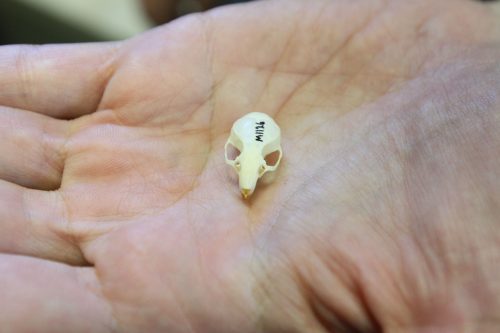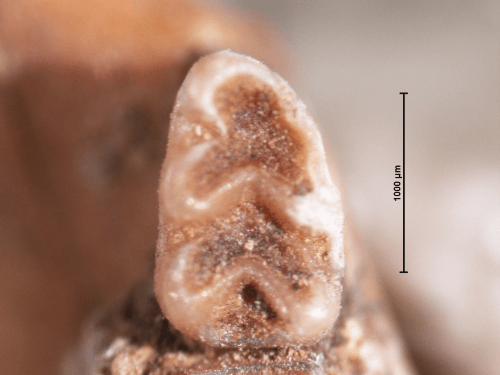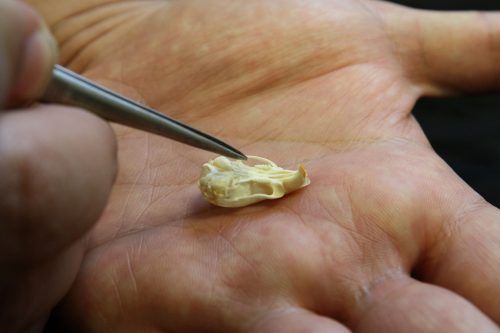The house mice's teeth revealed: Man settled in permanent settlements already 15,000 years ago - 3,000 years before the time it was common to think. "Until today, the main concept is that agriculture is the reason for permanent settlement. But our research found that the opposite may be true. Humans began to settle thousands of years earlier, and perhaps the fact that they settled in permanent settlements meant that they began to engage in agriculture," said Dr. Lior Weisbrod from the University of Haifa, who led the research.

The house mouse reveals: Humans settled in permanent settlements as early as 15 years ago, about 3,000 years earlier than the time when it is generally believed that permanent settlement began - with the beginning of the agricultural revolution, so reveals a new study conducted at the University of Haifa in collaboration with researchers from the National Center for Scientific Research in Paris and Washington University in St. Louis and was published today (Tuesday) in the prestigious journal PNAS. "Until today, the main concept is that agriculture is the reason for permanent settlement. But our research found that the opposite may be true. Humans began to settle thousands of years earlier, and perhaps the fact that they settled in permanent settlements meant that they began to engage in agriculture," said Dr. Lior Weisbrod from the University of Haifa, who led the research.
The house mouse is defined as a life that "companies with man" - a life that thrives in a human environment and travels with him wherever he goes. And indeed, from the moment when the agricultural revolution began and humans began to conquer the earth, the house mouse came with them all over the world. Therefore, the perception of most researchers was that the house mouse underwent the evolutionary adaptation from the wild mouse at the beginning of the agricultural revolution, about 12 thousand years ago. This view also holds that the agricultural revolution heralds the beginning of the permanent settlement of mankind, with the transition to agriculture being the main reason for the abandonment of the nomadic life of the hunter-gatherers and the transition to permanent settlement. Against this perception, there are researchers who claim that already in the Natufian culture, about 15,000 years ago, there are cases of permanent settlement, which preceded the agricultural revolution and may have been the cause of it.
The surprising results of the new research by Dr. Weisburd and Prof. Guy Bar Oz from the Zinman Institute of Archeology of the University of Haifa, together with Thomas Kuki, Fiona Marshall and others on the house mice clearly tips the scales in one direction.

In the study, the researchers examined mouse fossils from several prehistoric sites in Israel - from 200 years ago to about 10,000 years ago. The central and important site in the study was Einan, which is located in the Jordan Valley, near Kiryat Shmona. This is a site of the Natufian culture that was used by humans from 15,000 years ago to 11,500 years ago - in times when there was still no agriculture and until a little after the beginning of the agricultural revolution. The researchers wanted to try and differentiate in this way between the house mice and the wild mice - a task that became possible only thanks to the latest technology. "The length of the mouse's largest tooth is a little over a millimeter. There is no way to identify differences between the teeth of a house mouse and a wild mouse with the eye, not even with the help of a microscope. Only thanks to state-of-the-art digitization software were we able to give the teeth characteristics of length and shape - and thus try and differentiate between them," explained Dr. Weisbord.
The findings revealed that up until 15 years ago, all the teeth found at the various sites belonged to wild mice only, but then, 15 years ago - a complete change took place - 100% of the teeth from this period at the site in question belonged to house mice only. It was clear to the researchers that there must be an explanation for this change, and to find it they turned to Africa - to the Maasai tribe - a tribe whose lifestyle is similar to our hunter-gatherer ancestors. "The Maasai tribe lives a lifestyle of temporary permanent settlements. They settle down for a while, then migrate, and settle down again," the researchers explained. When they checked the distribution of house and wild mice among the Maasai, it turned out that about 80% of them are house mice and 20% wild mice. "If among temporary permanent residents we found 80% house mice, it was clear to us that 100% house mice are evidence of a permanent settlement," they said.

They also found that in later stages at the Einan site, there is a complete reversal again - this time, 100% of the teeth belong to wild mice. According to the researchers, this finding is consistent with the view that says that the Netuf were the first to settle in permanent settlements. "This concept holds that the Natufian culture operates in 'waves' - there are hundreds of years of permanent settlement, and then return to nomadic life again, and God forbid. Thus, until eventually the partial revolution comes and then the permanent settlement is no longer violated. The fact that we found in each such period 100% of mice of one type strengthens this perception. If we did not find 100% of a certain type, it would be difficult to say things with certainty, but according to our findings, it is clear that there are significant differences between the periods", said Prof. Bar Oz.
"Our findings indicate the following possibility: humans begin to settle in permanent settlements long before the agricultural revolution. The permanent settlement causes an impact on the environment, the adaptation of different animal species and an impact on the ecology and the environment. And perhaps it is this settlement that causes humans to start farming", concluded Dr. Weisbord.

6 תגובות
A very interesting theory, of the type (but now seriously) what came before the chicken or the egg.
I also do not see the publication on this or that stage as evidence of the correctness of a theory, but the summary of the article has beautiful ideas such as the proposal of a "bar" for examining permanent settlement.
I really miss a picture of a tooth of a wild mouse compared to the house mouse.
It is not clear from the article what the difference is between wild mouse teeth and house mouse teeth.
Is the difference evolutionary-genetic? Or maybe, the difference is due to differences in the signs of wear on the teeth, as a result of the difference in the diet of the mice?
If these are two different species of mouse, then it is a migration of the mice with the human tribes.
However, if these are differences in the signs of erosion, then wherever man settled he would return permanently, the local mice adapted to a diet of the remains of human food.
The migration of mice with man seems on the face of it to be an improbable possibility.
The possibility of local mice adapting to the human diet is more likely.
Is it possible to conclude from this that in the settlement the man's business was necessarily fixed in agriculture? I think not necessarily.
If it was a natural environment abundant with plants and animals, it is possible that it was a company of hunters who lived in a permanent settlement.
In this article, there is a great lack of additional findings that would corroborate this theory, whether it was written by a prestigious pen or not is not what makes the difference - here there is only a huge theory about the development of man and agriculture... that stands on the knees of a mouse.
There is an internal contradiction here
Claim 1: "The house mouse passed the evolutionary adaptation from the wild mouse with the beginning of the agricultural revolution",
This means that the house mouse is a result of the agricultural revolution.
Claim 2: "It is clear to us that 100% of house mice are evidence of a permanent permanent settlement"
This means that the house mouse is the result of permanent human settlement.
"Humans begin to settle in permanent settlements long before the agricultural revolution"
Why??? If the house mouse is found 15000 years ago, according to claim 1 the agricultural revolution was 15000 years ago.
Avi,
The real question is what do you believe in principle - the academy or the rabbi?
After all, you have not read the article itself here, but a very concise summary written for the reader from the street.
To me, too, the theory sounds like it depends on a lot of factors, but from here to "so ragged and flimsy" - I would be careful.
As someone who has read a few academic papers in his life, I am convinced that the original paper had reference to how the teeth define the type of mouse. I only assume that the researchers involved in the field already know that the technology that will be used by the researchers works because it is likely that this was not the first study that was experimented with.... I mean there are years of experience and work behind research and articles and what to do some of the theories that the article was based on already sit quite well with the researchers and their colleagues. I'm not saying that there aren't fantastic articles that come out just for the researcher's livelihood - but this is indeed a prestigious journal, so a little modesty
It sounds completely delusional, about the same as the scene in the movie of Columbo, who recreated a murdered man's claustron from a piece of bone from his leg that was found inside a concrete pillar...
Researchers discover a feature that only digitizing software can distinguish with the help of length and shape characteristics... in a microscopic fossilized mouse tooth.... They build wires and wires of dubious theories that this is how you can distinguish between the house mouse and the field mouse, and from that they build a theory of the development of the mouse and from that they build a theory about the settlement of humans millions of years ago...
It's lucky that it was published in a prestigious journal... it sounds such a flimsy and shaky theory and so unscientific that I would have thought it was a new conspiracy theory against paleo.